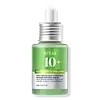What's inside
What's inside
 Key Ingredients
Key Ingredients

 Benefits
Benefits

 Concerns
Concerns

 Ingredients Side-by-side
Ingredients Side-by-side

Water
Skin ConditioningAzelaic Acid
BufferingGlycerin
HumectantPropanediol
SolventGlycereth-26
HumectantAvena Sativa Kernel Flour
AbrasiveCarnosine
Skin ConditioningAcetyl Tetrapeptide-2
Skin ConditioningCeramide NP
Skin ConditioningCeramide EOP
Skin ConditioningCeramide Ns
Skin ConditioningCeramide As
Skin ConditioningCeramide AP
Skin ConditioningGallyl Glucoside
AntioxidantPropyl Gallate
AntioxidantEpigallocatechin Gallatyl Glucoside
AntioxidantDaucus Carota Sativa Root Cell Culture Lysate
Skin ConditioningGossypium Herbaceum Callus Culture
Skin ConditioningSphingomonas Ferment Extract
Skin ConditioningEthylhexylglycerin
Skin ConditioningHydrogenated Lecithin
EmulsifyingSucrose Distearate
EmollientGlyceryl Stearate
EmollientDipropylene Glycol
HumectantDehydroacetic Acid
PreservativeCaprylyl Glycol
EmollientPhenoxyethanol
PreservativeTriethanolamine
BufferingBenzyl Alcohol
PerfumingCitric Acid
BufferingWater, Azelaic Acid, Glycerin, Propanediol, Glycereth-26, Avena Sativa Kernel Flour, Carnosine, Acetyl Tetrapeptide-2, Ceramide NP, Ceramide EOP, Ceramide Ns, Ceramide As, Ceramide AP, Gallyl Glucoside, Propyl Gallate, Epigallocatechin Gallatyl Glucoside, Daucus Carota Sativa Root Cell Culture Lysate, Gossypium Herbaceum Callus Culture, Sphingomonas Ferment Extract, Ethylhexylglycerin, Hydrogenated Lecithin, Sucrose Distearate, Glyceryl Stearate, Dipropylene Glycol, Dehydroacetic Acid, Caprylyl Glycol, Phenoxyethanol, Triethanolamine, Benzyl Alcohol, Citric Acid
Water
Skin ConditioningAzelaic Acid
BufferingPropylene Glycol
HumectantSodium Hydroxide
BufferingDipropylene Glycol
Humectant1,2-Hexanediol
Skin ConditioningPanthenol
Skin ConditioningHydroxyethylcellulose
Emulsion StabilisingBetaine Salicylate
AntimicrobialGlycerin
HumectantBiosaccharide Gum-1
HumectantEthylhexylglycerin
Skin ConditioningAllantoin
Skin ConditioningDipotassium Glycyrrhizate
HumectantMelia Azadirachta Leaf Extract
Skin ConditioningCamellia Sinensis Leaf Water
MaskingSodium Hyaluronate
HumectantMelia Azadirachta Flower Extract
Skin ConditioningNiacinamide
SmoothingAloe Barbadensis Leaf Juice
Skin ConditioningBeta-Glucan
Skin ConditioningCentella Asiatica Extract
CleansingCentella Asiatica Leaf Extract
Skin ConditioningCentella Asiatica Root Extract
Skin ConditioningMadecassoside
AntioxidantAsiaticoside
AntioxidantAsiatic Acid
Skin ConditioningMadecassic Acid
Skin ConditioningSqualane
EmollientZinc PCA
HumectantButylene Glycol
HumectantPentylene Glycol
Skin ConditioningCaprylyl/Capryl Glucoside
CleansingHydrogenated Lecithin
EmulsifyingCeramide NP
Skin ConditioningWater, Azelaic Acid, Propylene Glycol, Sodium Hydroxide, Dipropylene Glycol, 1,2-Hexanediol, Panthenol, Hydroxyethylcellulose, Betaine Salicylate, Glycerin, Biosaccharide Gum-1, Ethylhexylglycerin, Allantoin, Dipotassium Glycyrrhizate, Melia Azadirachta Leaf Extract, Camellia Sinensis Leaf Water, Sodium Hyaluronate, Melia Azadirachta Flower Extract, Niacinamide, Aloe Barbadensis Leaf Juice, Beta-Glucan, Centella Asiatica Extract, Centella Asiatica Leaf Extract, Centella Asiatica Root Extract, Madecassoside, Asiaticoside, Asiatic Acid, Madecassic Acid, Squalane, Zinc PCA, Butylene Glycol, Pentylene Glycol, Caprylyl/Capryl Glucoside, Hydrogenated Lecithin, Ceramide NP
 Reviews
Reviews

Ingredients Explained
These ingredients are found in both products.
Ingredients higher up in an ingredient list are typically present in a larger amount.
Azelaic acid is a multitasker ingredient that helps treat acne, pigmentation, and irritation. It is a great option for sensitive skin.
What makes azelaic special?
The best thing about azelaic acid is it's gentleness. It's generally well-tolerated and safe to use alongside other actives like niacinamide or salicylic acid.
Unlike AHAs, azelaic acid will not make you photosensitive/sun sensitive.
You can find this ingredient naturally occurring in grains like wheat, rye, and barley. In cosmetics, azelaic acid is typically lab-made, which is more stable and effective.
Learn more about Azelaic AcidCeramide NP is a type of ceramide and formally known as ceramide 3.
Ceramides are intercellular lipids naturally found in our skin that bonds dead skin cells together to create a barrier. They are known for their ability to hold water and thus are a great ingredient for dry skin.
Ceramides are an important building block for our skin barrier. A stronger barrier helps the skin look more firm and hydrated. By bolstering the skin ceramides act as a barrier against irritating ingredients. This can help with inflammation as well.
If you would like to eat ceramides, sweet potatoes contain a small amount.
Read more about other common types of ceramides here:
Ceramide AP
Ceramide EOP
Dipropylene Glycol is a synthetically created humectant, stabilizer, and solvent.
This ingredient helps:
Dipropylene glycol is technically an alcohol, but it belongs to the glycol family (often considered part of the ‘good’ alcohols). This means it is hydrating and gentle on skin unlike drying solvent alcohols like denatured alcohol.
As a masking agent, Dipropylene Glycol can be used to cover the smell of other ingredients. However, it does not have a scent.
Studies show Dipropylene Glycol is considered safe to use in skincare.
Learn more about Dipropylene GlycolEthylhexylglycerin (we can't pronounce this either) is commonly used as a preservative and skin softener. It is derived from glyceryl.
You might see Ethylhexylglycerin often paired with other preservatives such as phenoxyethanol. Ethylhexylglycerin has been found to increase the effectiveness of these other preservatives.
Glycerin is already naturally found in your skin. It helps moisturize and protect your skin.
A study from 2016 found glycerin to be more effective as a humectant than AHAs and hyaluronic acid.
As a humectant, it helps the skin stay hydrated by pulling moisture to your skin. The low molecular weight of glycerin allows it to pull moisture into the deeper layers of your skin.
Hydrated skin improves your skin barrier; Your skin barrier helps protect against irritants and bacteria.
Glycerin has also been found to have antimicrobial and antiviral properties. Due to these properties, glycerin is often used in wound and burn treatments.
In cosmetics, glycerin is usually derived from plants such as soybean or palm. However, it can also be sourced from animals, such as tallow or animal fat.
This ingredient is organic, colorless, odorless, and non-toxic.
Glycerin is the name for this ingredient in American English. British English uses Glycerol/Glycerine.
Learn more about GlycerinHydrogenated Lecithin is created from the hydrogenation of lecithin (a group of phospholipids). Hydrogenation is a chemical reaction between hydrogen and another element.
This ingredient is an emollient and emulsifier. As an emollient, it helps soften skin by trapping moisture within. As an emulsifier, it prevents oil and water ingredients from separating.
Water. It's the most common cosmetic ingredient of all. You'll usually see it at the top of ingredient lists, meaning that it makes up the largest part of the product.
So why is it so popular? Water most often acts as a solvent - this means that it helps dissolve other ingredients into the formulation.
You'll also recognize water as that liquid we all need to stay alive. If you see this, drink a glass of water. Stay hydrated!
Learn more about Water